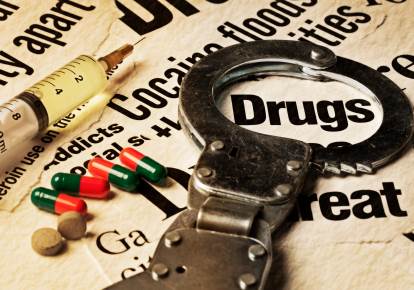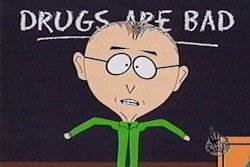 Driving under the influence of drugs sounds really bad, and this topic has received a lot of attention lately in the media. Images of teenagers driving like lunatics in Reefer Madness dovetail with the traditional images of drunk drivers sauced up and toting bottles enclosed in brown paper bags.
Driving under the influence of drugs sounds really bad, and this topic has received a lot of attention lately in the media. Images of teenagers driving like lunatics in Reefer Madness dovetail with the traditional images of drunk drivers sauced up and toting bottles enclosed in brown paper bags.
We have been indoctrinated through images and propaganda designed to underscore a message of fear, but these ads are far from the truth. The typical “drugged driver” is a normal everyday person accused of a very serious crime, and the evidence used to prosecute that person is largely based upon a police officer’s opinion.
Have you taken too much of a prescription drug before driving? You might be in trouble. But many people across the nation have been accused of driving under the influence of drugs for taking the normal prescribed amount, including lawyers, doctors, and judges. Have you consumed an illegal drug before driving? This can also be bad, if true, but Michigan drug testing is extremely unreliable.
Michigan has two primary laws that proscribe driving under the influence of drugs, and one is relatively new. The older of these two laws makes sense ("Operating While Under the Influence of a Drug") but can be manipulated in ways that were never intended, and the newer law ("Any Amount") simply makes no sense but makes a prosecutor’s job easy.
The older law states that it is unlawful to operate a motor vehicle while intoxicated. It is the same law used to prosecute drivers who are intoxicated by alcohol. It says that it is unlawful to drive while intoxicated, and the definition of what it means to be intoxicated states that “[t]he person is under the influence of alcoholic liquor, a controlled substance, or a combination of alcoholic liquor and a controlled substance.” MCL 257.625(1)(a). If a person drinks a few beers, smokes a couple of joints, and does a couple of lines before driving, that driver can be prosecuted if the motorist is “under the influence” of those substances. Pretty simple, at least in theory.
 The new law prohibits driving with the presence of “any amount” of certain substances. MCL 257.625(8). The prohibited substances under this law include all Schedule 1 drugs, which are highly addictive drugs with no medical value, as well as cocaine and marijuana. Cocaine was tacked on because it is a favored law enforcement target, and marijuana was included even though Michigan now recognizes its medical properties. The problem with this law is that a chemical test might reveal trace elements of prohibited drugs from days or even months prior to driving. With increasingly sensitive ways of detecting drug exposure, it is possible to detect marijuana in a person’s body even when it has not been smoked. This is incredibly stupid.
The new law prohibits driving with the presence of “any amount” of certain substances. MCL 257.625(8). The prohibited substances under this law include all Schedule 1 drugs, which are highly addictive drugs with no medical value, as well as cocaine and marijuana. Cocaine was tacked on because it is a favored law enforcement target, and marijuana was included even though Michigan now recognizes its medical properties. The problem with this law is that a chemical test might reveal trace elements of prohibited drugs from days or even months prior to driving. With increasingly sensitive ways of detecting drug exposure, it is possible to detect marijuana in a person’s body even when it has not been smoked. This is incredibly stupid.
Law enforcement officers, lawyers, and judges frequently confuse the two laws. To clarify the difference: if a doctor can prescribe it, and it is neither cocaine nor marijuana, the charge cannot be an “any amount” violation. On the other hand, if the charge involves one of these prohibited substances, it could qualify under both laws depending upon the facts of the case.
To prove that a motorist is “under the influence” of a controlled substance, the prosecutor must prove that the person’s “ability to drive was substantially and materially affected by consumption of” the controlled substance. On the other hand, an “any amount” charge only requires evidence of driving and a test revealing the presence of the proscribed drug. The prosecutor does not need to prove any pharmacological effect at all. People v Derror, 475 Mich 316 (2006). In other words, the driver is drunk even though no evidence attempts to prove that the motorist was drunk or even impaired by the presence of the substance.
The draconian nature of the “any amount” law aside, the older law is subject to abuse because that statute prohibits driving under the influence of a broad category of drugs defined as a “controlled substance.” In the hands of creative police officers and overly aggressive prosecutors, this common sense law has been subjected to torturous manipulation. It also has some notable holes in it. A “controlled substance” is defined by the Public Health Code. The Legislature and administrative boards have carefully categorized various substances into drug schedules. It is a bureaucratic fantasy in the real world of medicine.
Unfortunately, this laundry list of substances was adopted wholesale into the drunk driving laws without regard to the impairing effect of the drugs. In the hands of police and prosecutors, the broadly defined list of controlled substances is subject to abuse. Technically, if an officer describes diminished driving abilities, a motorist can be charged with driving under the influence of Viagra, Tegretol, or Xyrem. You are probably familiar with Viagra, but Tegretol is an anti-seizure medication used to treat epilepsy, and Xyrem is a drug used to treat narcolepsy. Quite frankly, drivers prescribed with either Tegretol or Xyrem should not be driving if they are NOT under the influence of those drugs.
Real world difficulties arise when police officers charge motorists with driving under the influence of Xanax, a benzodiazepine, or Vicodin, a narcotic. These drugs can potentially result in euphoria and diminished driving abilities, especially if they are abused and combined with alcohol. These are also popular drugs that are frequently abused. Ritalin, a psychostimulant drug used for treating attention-deficit hyperactivity disorder, can also be abused, but the only published study regarding Ritalin and driving performance shows a remarkable improvement in driving performance for those suffering from attention-deficit disorder.
Even though some drugs can be abused, normal everyday people take drugs like Xanax, Vicodin and Ritalin and drive to work each day. Some of these notorious drug users might even have a drink after work. Cancer patients may be prescribed pain relievers at dosage levels that would kill a normal person, and yet these folks are merely managing pain and drive safely.
So how can we decide who is “intoxicated” and “under the influence” of a controlled substance? Therein lies the problem. In the hands of a creative police officer, a stone-cold sober motorists can be described as falling down drunk. Hokey field sobriety tests are failure designed tests that cannot fairly measure intoxication, but aggressive prosecutors will sermonize on this flawed junk science, declaring that the motorist "failed" the HGN, the "walk and turn" and the "one leg stand" test. And unlike the .08 law that exists for alcohol, lawmakers have been unsuccessful at creating similar legal limits for drugs because the pharmacological effect of a drug varies so dramatically from one person to the next.
Finally, some notable holes under Michigan’s drunk driving statute were cleared up in a recent amendment to the drunk laws by adding the setence "an impairing substance." Many substances can impair driving abilities but were not classified as “controlled substances” under the public health code. For instance, “huffing” inhalants can seriously impair driving abilities, but these abused substances are never prescribed by a doctor or pharmacist so they were not defined as a “controlled substance.” Now, a motorist may be charged with driving under the influence of an "impairing substance" in addition to alcohol, a schedule 1 substance, or a controlled substance. This will create a litany of new problems for presumably innocent drivers opposed by police officers and aggressive prosecutors, with all sorts of crazy implications.